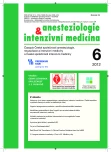Identification of potential organ donors after irreversible cardiac death (DCD) in the intensive care unit
Authors:
Schmidt Matouš 1,2; Pokorná Eva 3; Fric Michal 1; Duška František 2,4
Authors‘ workplace:
Klinika anesteziologie a resuscitace, Fakultní nemocnice Královské Vinohrady, Praha
1; Univerzita Karlova v Praze, 3. lékařská fakulta, Praha
2; Transplantcentrum IKEM, Praha
3; Adult Intensive Care Unit, East Midlands Major Trauma Center, Nottingham, Velká Británie
4
Published in:
Anest. intenziv. Med., 23, 2012, č. 6, s. 295-299
Category:
Intensive Care Medicine - Original Paper
Overview
Objective:
To identify potential organ donors after cardiac death (DCD) in the intensive care unit.
Design:
Retrospective, observational, single-center study.
Setting:
Department of Anaesthesiology and Intensive Care Medicine, University Hospital.
Materials and methods:
Out of 1513 patients admitted between 2010 and 2011, we retrospectivelytested the ability of the subgroup of nonsurvivors to become DCD organ donors.
Results:
23 patients were diagnosed as brain dead and became organ donors (DBD). Another 21 patients met the criteria for donors after cardiac death.
Conclusion:
Implementation of the DCD programme would significantly increase the number of organdonors (by up to 50% in our institution).
Keywords:
DCD – donors after cardiac death – transplantation program – paliative therapy
Sources
1. Pokorná, E. Zemřelí dárci orgánů k transplantacím. Čas. Lék. čes., 2011, 150, s. 34–36.
2. Domínguez-Gil, B., Haase-Kromwijk, B., Van Leiden, H. et al. Current situation of donation after circulatory death in European countries. Transpl. Int., 2011, 24, 7, p. 676–686.
3. U. S. Organ Donors by Organ and Donor type OPTN/SRTN Annual Report: http://optn.transplant.hrsa.gov/ar2009/101_dh.htm?o=1&g=3&c=0, [poslední přístup 14.9.2012].
4. Jochmans, I., Darius, T., Kuypers, D., Monbaliu, D. et al. Kidney donation after circulatory death in a country with a high number of brain dead donors: 10-year experience in Belgium. Transpl. Int., 2012, 25, 8, p. 857–866.
5. Bernat, J. L., Capron, A. M., Bleck, T. P. et al. The circulatory-respiratory determination of death in organ donation. Crit. Care Med., 2010, 38, p. 963.
6. Bernat, J. L. The boundaries of organ donation after circulatory death. N. Engl. J. Med., 2008, 359, p. 669–671.
7. Transplantační zákon (285/2002 Sb.). http://www.pravnipredpisy.cz/predpisy/ZAKONY/2002/285002/Sb_285002_php [poslední přístup 17. 7. 2012].
8. Doporučení představenstva ČLK č. 1/2010 k postupu při rozhodování o změně léčby intenzivní na léčbu paliativní u pacientů v terminálním stavu, kteří nejsou schopni vyjádřit svou vůli. http://www.csarim.cz/Public/csim/dop-CLK-2010-31.pdf, [poslední přístup 17.7.2012]
9. Černý, V., Pařízková, R., Dostál, P., Jahodářová, R.,Herold, I., Nalos, D. Ukončování ventilační podpory u nemocných v intenzivní péči. Anest. intenziv. Med., 2001, č. 2, s. 64–68.
10. Kompanje EJO, van der Hoven, B., Bakker, J. Anticipation of distress after discontinuation of mechanical ventilation in the ICU at the end of life. Int. Care Med., 2008, 34, p. 1593–1599.
11. Donation after Circulatory Death. Report from concensus meeting. 2010. http://www.ics.ac.uk/intensive_care_professional/standards_and_guidelines/dcd [poslední přístup 18.7.2012]
Labels
Anaesthesiology, Resuscitation and Inten Intensive Care MedicineArticle was published in
Anaesthesiology and Intensive Care Medicine

2012 Issue 6
Most read in this issue
- Current position and use of intravenous immunoglobulins not only in intensive care medicine
- Acute warfarin reversal and the use of subarachnoid anaesthesia
- Identification of potential organ donors after irreversible cardiac death (DCD) in the intensive care unit
-
Red Blood Cell Transfusion: A Clinical Practice Guideline from the AABB
(American Association of Blood Banks)
